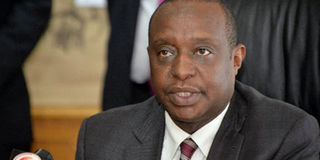What we need to know about Eurobond and soaring debt

National Treasury Cabinet Secretary Henry Rotich. Mr Rotich and his team have a tough and rather unenviable job both in the short and medium term. Making government expenditure more efficient is one. PHOTO | SALATON NJAU | NATION MEDIA GROUP
What you need to know:
- The ratio of debt service of a country is what a country pays back in debt both domestically and internationally.
- The just closed TB offers are another good example of government “borrowing from Peter” to in part “pay Paul” as it struggles to meet debt repayments of around Sh85 billion which are falling due.
It is useful to draw back from the contentious battle lines of the Eurobond loan debacle and look at some of the broader issues.
One is the whole issue of government debt and borrowing and related to that the various options open to government in terms of funding its operations.
In theory the ideal scenario for a government is to balance its books so that what it raises from taxes and other forms of revenue is enough to pay its expenditure, bills and other financial commitments.
This is often an almost impossible task if, for example, one inherits a legacy of over borrowing or accumulated debt incurred by previous governments.
Another is if there has been serious borrowing for major infrastructure projects.
It is useful to remind ourselves that the Kibaki era was one of those.
A number of key infrastructural projects were conceived and started during that time, including the standard gauge railway (SGR).
While it is possible to tone down or amend some of those commitments, it is very difficult and expensive to just halt them or throw them away.
Indeed, it was around the time the SGR was started that our debt service ratio edged up and then pushed past the 50 per cent mark.
The ratio of debt service of a country is what a country pays back in debt both domestically and internationally.
Kenya may not be in the same boat as, for example, Greece but its debt is increasing at a faster rate than is comfortable.
Where it starts to get tricky is when one gets caught in a web of debt.
One way this happens is when a government is keen to get another loan to use a significant part of the proceeds to honour other debt repayments.
DOMESTIC BORRORING
In the run-up to the Eurobond agreement, there was a flurry of activity to clear some due multilateral payments.
As explained, it was important to sort out the latter to access the former.
Domestic debt is accumulated when a government has a problem meeting its day to day commitments and payments.
It will then resort to raising money on the domestic market as the government is doing through its recently closed two-year and ten-year Treasury Bond (TB) issues.
Borrowing from the domestic market is a direct competitor to the day to day running of the government because it is demanding its share of those resources for debt repayment rather than for goods, services and development.
Domestic borrowing rates have been traditionally higher than international borrowing rates.
The just closed TB offers are another good example of government “borrowing from Peter” to in part “pay Paul” as it struggles to meet debt repayments of around Sh85 billion which are falling due.
Another relative negative is the more one borrows domestically the more one starves or “crowds out” the private sector both in availability and because the cost of borrowing gets pushed up.
How it gets linked to international debt is because the government may resort, from time to time, to borrow from the international market, as it did with the Eurobond, or from multilateral lenders such as the IMF.
On paper this may look a cheaper option but the downside is the exchange rate risk and of course any other risks that international lenders may factor into the rate.
RECOMMENDATIONS
So what are the answers or solutions? Unfortunately there is no silver bullet.
Government must step up its act of streamlining and making more efficient and productive its payment and expenditure process.
Ideally, this should involve genuine expenditure cuts of waste rather than cuts in real goods and services and delays in payment.
Raising more revenue via taxes can be a double edged sword as it can often result in less demand and activity, which in turn blunts revenue collection.
The international side of the balance of payments and debt conundrum is worse.
Kenya has had a structural weakness for some time.
What it earns from exports, tourism and other inputs like diaspora remittances is not enough to pay for its imports and other foreign exchange costs.
Under the global trade regime it is difficult to restrict imports except maybe by higher tariffs.
At the same time a very significant chunk are inputs and raw materials for manufacturing and agriculture and of course for our various infrastructure projects.
Our earners such as tourism, tea, coffee and to a lesser extent horticulture and floriculture are very much susceptible to the demand and supply vagaries of the international global market.
All in all, Treasury CS Henry Rotich and his team have a tough and rather unenviable job both in the short and medium term. Making government expenditure more efficient is one.
Handling current debt issues is another. Trying to stem the rise of increasing indebtedness is yet another.
Last but not least, there is the challenge of strengthening our overall terms of trade.
Robert Shaw is an economic and public policy analyst





